Sep 30 2016
My Journey – The Beginning
I’ve always been extremely curious about this historically important and visually stunning method of image-production, but my love for daguerreotypes was really sparked in 2012, when, while being on my first cross country trip aboard The Photo Palace Bus, I had the extreme pleasure and luck of meeting Rob McElroy in Buffalo NY. You can read about that incredible adventure and see some images HERE and then a followup HERE. Aside form being simply an amazing human being, Rob is one of the very best in the world when it comes to this form of art and I was truly astounded by his work and the whole process. The bug got it’s bite and since then I have been dreaming about making my own plates. Daguerreotype equipment though is extremely expensive – the safety that must be factored into mercury pots and low demand leading to very small number of people producing this stuff both contribute to the cost factor, and that’s not even to mention the plates – pure silver isn’t cheap… So my desire to become a daguerreotype artist seemed far off and nearly unattainable.
In 2012 though I wasn’t even doing wet plate…. Well, in 2013 I learned to worked with collodion, got acquainted with the community and lo and behold – one of the folks who was living right in San Diego did both collodion and daguerreotypes! Race Gentry is now a good friend of mine and we hang out as often as his busy life and school schedule lets us. He has been kind enough to let me use his equipment to start learning and also shared a wealth of knowledge that he accumulated over the years both from experience and by reading historic literature on the subject. Right now I’m in the final stages of gathering up all my own equipment, but I know that Race and I will be friends regardless – he’s just too much fun to hang out with.
So, with Race’s help I started making becquerel plates last year. I made some fairly good ones rather quickly as it’s not all that complicated of a technique.
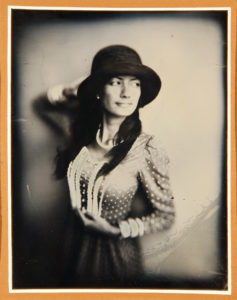
4x5in
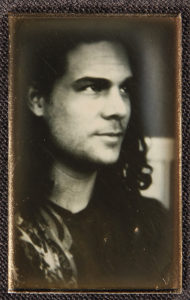
35mm
The lack of fine tonality and long exposures (25sec for the two you see above) made me become rather bored rather quickly. Don’t know why I took so long after that boredom set in to start pursuing success with real mercury daguerreotypes, but I only really dedicated myself to this task a couple of months ago. During that time there were periods when I made multiple images a day for a week or two straight and then there were times when discouraged I took breaks only to return with more force later.
I’m not going to try to make is sound like obtaining a decent-looking plate is the hardest thing in the world. I’m sure climbing Mt. Everest to the summit, running 100m under 10sec, truly understanding women or making a mentally challenged squirrel be able to teach calculus are all things that are harder. However daguerreotypes have their challenges and quirks and overcoming (or at least sidestepping) them have proven to be quite a feat for yours truly.
First there’s buffing – that darn plate must be so perfect and so clean and so much like a mirror that sometimes it seemed that I’ll never get it… Then there’s fuming – it’s done by visual inspection and there’s only a small window of particular hues of pink that works best and to top that off the proportion of iodine to bromine that is used in achieving that hue reflects on both speed of the plate and contrast of the final image. Next there’s development – that’s relatively straight forward, one just have to find an optimal combination of mercury temperature and development time that doesn’t go too long and lets mercury globs to accumulate in the shadow areas (like the ones you see in the below image of a box camera in the center – that one’s under-exposed so in vain I tried pushing development, something that you just can’t do with daguerreotypes). OH, and then, after you might have gotten the best results you have seen in your plates you have to gild that thing and THAT is one conniving and malicious step I tell you! The most perfect plate can go to being absolute garbage right in front of your eyes literally in a span of a few seconds and there’s not a single thing you can do to stop that once it starts happening… To top it all off almost every single practicing daguerreotype image maker I have asked seems to have their own unique workflow that works for them – sometimes steps vary only slightly from one person to another and in other instance it made me wonder if they are even working on the same technique…. All advice was taken with stride and a grain of salt.
OK – time for some images.
All 5 of the good (and in the eyes of some that may be a stretch of the word ‘good’) images you see below are copied after gilding.
Here’s a an image I did yesterday – I believe it’s my best mercury plate so far and I was extremely excited when gilding didn’t ruin it completely (some back spots in the sky did show up, but I have a faint hunch about what may have caused that, so let’s see if in the next few sessions I can prevent them from occurring again).
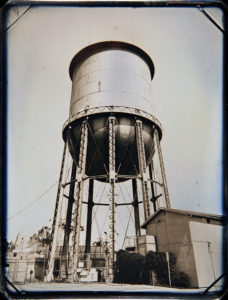
1/4 plate
Now let’s quickly compare the above plate to just a few of the plates that I deemed worthy of copying with my phone camera during the long and windy road of learning the craft.
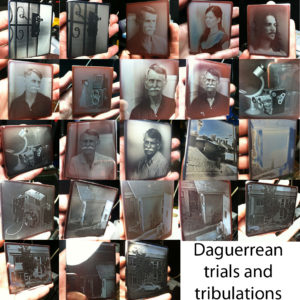
Progress is evident, no? Here’s a few more recent images made after last week I for one reason or another had what seemed like a breakthrough. This was the first one I made that wasn’t awful – as I said above, it’s about a full stop or maybe even two underexposed and I tried correcting that by pushing development time past where it should have ended, but in real life now it actually looks not too bad thanks to the amazing Carillo Method of brightening gilded images – this method was discovered very recently by Daniel Carrillo of Portland OR and, if it works right, it does wonders to dull images. Let me tell you though it doesn’t exactly work perfect every time, at least it hasn’t for me…

4x5in
Here’s is the first portrait I was truly happy with – even the gilding spared it from irregularities. To top it off this is the first daguerreotype plate that I sold, so thank you very much Robert Matheson!
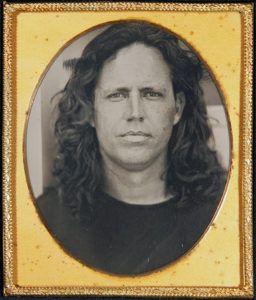
1/6 plate
Oh, and of course here’s Fred – the wonderfully patient man of kind temper who resides across the stairs form my darkroom. In the compilation of failed images above you see how many times he posed for me and not once was he reluctant to do so. He is a true gentleman and a scholar. It is unfortunate that during gilding the stain on bottom right decided to appear, but otherwise I believe it’s a solid plate in all respects.

1/6 plate
And here’s a still life composition – my little homage to the old-times, the photographers who came before me, the tools they used and the people who passed in front of their lenses.
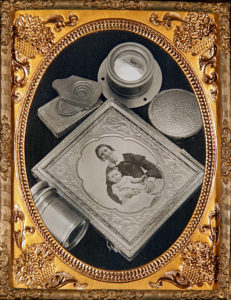
1/4 plate
Anton Orlov
Comments Off on My Journey – The Beginning